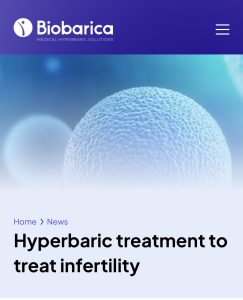
It is estimated that between 15% and 25% of couples suffer from infertility. Among that percentage, 39% comes from the female part and 20%from the male part. The women’s fertility reduces naturally with age, this is because the quality of the oocytes and the ovarian reserve decreases. From the age of 45 years, the possibility of having a successful pregnancy is low. Indeed, a healthy and fertile woman of 30 years old has only a 20% of chances to get pregnant regardless of the method chosen. After the age of 40, the chances reduce to 5%.
Also, there are some cases of infertility, both feminine and masculine, that come from different pathologies such as endometriosis, in the case of women, and erectile dysfunction in male patients. However, the fertility field has paid special attention to hyperbaric medicine because of the benefits of oxygen.
Hyperbaric oxygen therapy (HBOT) produces a significant increase of oxygen in blood promoting a better functioning of the organism, stimulating angiogenesis, and regulating oxidative stress. The physiological effects generated by hyperoxia can promote a better scenario for fertilization to occur correctly and, enhance assisted fertility treatments.
In the feminine case, the HBOT contributes to improving ovulation and the quality of the ovule. Also, It is involved in the preparation of the endometrium and the quality of the endometrium for implantation. Angiogenesis and blood flow in the ovary is necessary for the process of ovogenesis, especially for the development of the follicle. Several trials have demonstrated that oxygen is necessary for the meiosis of the oocyte and those that enjoy a better blood flow have better quality to be extracted for in vitro fertilization. In this sense, hyperbaric chamber sessions can be used as an adjuvant method because one of its main benefits is to improve perfusion thanks to the formation of new blood vessels.
In patients who suffer from endometriosis, the anti-inflammatory effect of HBOT helps to reduce the inflammatory response of TLR4 in different organs, reducing the chronic inflammation at the systemic level.
On another hand, infertility in men can be presented by genetic conditions, erectile dysfunction, or bad habits, such as smoking and obesity, affecting sperm quality. The mechanism of action of HBOT in sperm functionality is directly involved with the mechanism of action of oxygen on sperm mitochondria. These mitochondria, not only are necessary for ATP production, sperm functionality, and the movement of the tail for the scrolling, but also have an important role to keep the regulation of the oxidative balance, oxidative stress, and enzymes to regulate it.
In dysfunctional erectile, angiogenesis can reverse the disruption of vascular blood flow in the penis, which is usually present in 60% of such cases. It also reduces testicular ischemia-reperfusion damage so it could be used as a preventive treatment for secondary infertility in situations of testicular torsion and spinal cord injuries.
In conclusion, hyperbaric oxygen treatment can be a coadjuvant therapy that helps to prevent and promote infertility treatment by improving the fertilization period. Also, it generates a favorable environment for successful implantation.